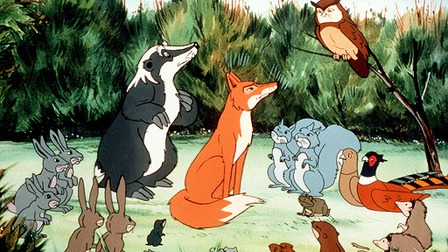Now I'm here to put things right and delve into the past, this is a nostalgic look at the talking animals that inhabit these programmes, their cute little personalities, the idyllic English countryside and how rabbits tear the living shit out of each other in vicious subterranean battles.
I think what ever age I saw that scene it would still have traumatized me.
While these animated tales of animals in adversity are on the face of it, for children, Watership Down especially doesn't pull any punches when it comes to illustrating the harsh realities of the natural world.
The Animals of Farthing Wood
The title sequence reminds us every episode why the animals are so called, it replays the sequence where bulldozers, seen from the terrifying worms eye view of the animals, come and trash Farthing Wood to make a soulless wasteland of concrete (you maniacs!).
The animals barely escape with their lives, and regroup to decide what to do. The toad among them has heard of a nature reserve: White Deer Park and the quest is all lined up, they just have to negotiate the human infested countryside full of peril.
To add to the peril, the group of animals is an assortment of species that would usually eat each other.
A weird mix
An owl, a kestrel, a badger, some rabbits, hares, some fieldmice, some squirrels, some voles, a toad, a mole, a weasel, an adder, some news, some pheasants, some hedgehogs and of course the foxes (sounds like a pain the arse for an animator). Fox assumes the role of leader (not vixen obviously). In order to survive the various sources of peril they take an oath to protect each other until they complete their journey. Needless to say, when critters get hungry this oath comes under stress.
Like any other displaced population, the animals are out of their element and face all kinds of things strange to them. The animal perspective of a world created by humans is a great way to demonstrate how much we
have torn up the natural habitat of this country and how forbidding it is to most wildlife.
Gruesome death
I had to research a lot of this detail (eg I don't remember any newts, do you?), but one episode that stays in my head is when they have to cross a motorway. The squirrels are good climbers and make it over a bridge type thing.
The other creatures make it to the central reservation where one of the rabbits is almost poisoned by trying to eat the grass, but where are the hedgehogs? They were always the slowest. They were too spiky to be carried by anyone, whats that one doing? CURLING UP IN A BALL WON'T HELP! A lorry looms... cut to the other animals' shocked faces... sad music plays.
 Brutal that was. There was just too much peril for slow ass hedgehogs.
Brutal that was. There was just too much peril for slow ass hedgehogs.But the natural world is brutal, and the sooner these kids learn it the better! Not that I'm bitter or anything.
Watership Down
Like the Animals of Farthing Wood, this was a novel in the 70s before it translated into animation. The author Richard Adams based some of the detail of his stories on battles his friends lived through in WWII. This shows in some of the darker scenes.
 |
| As much as I hate this guy, he got big balls in this scene. He takes on a dog! |
There is a sort of culture and mythology woven into this story that gives it a bit more depth, and it focuses solely on rabbits. But in other respects there are many similarities between the two gritty children's tales: Humans come and destroy the home of the animals (in this case they're warned by a tripped out runt rabbit in one of his visions), and they are trying to find a new home, in this case the name of the tale refers to the place of their salvation rather than where they came from.
Warrior rabbits
In this story there is a warrior class of rabbit, the Owsla, and Bigwig is the muscle of the group. Hazel, previously a bit of a nobody, comes into his own when the party leave their old home and has the brains to lead them.
Even though rabbits seem like an odd choice for central characters, the preamble to the story (a legend about how the different animals came to be) makes them an interesting one. In the intro the creator says:
"all the world will be your enemy, and when they catch you, they will kill you. But first they must catch you"
The rabbits are built for listening and for running. This anatomical result of evolution (or the work of a god) reminds us the rabbits are "the hunted" and adds to their vulnerability. This sense of them and nature as something vulnerable is a helpful message.
Hope for humans
The most poignant scene in the film, for me, is when Hazel is about to be killed by a cat. A little girl comes out of the house to his aid. Despite the influence of man in the rest of the film leading to the capture and demise of dozens of rabbits, this scene, shows that there is a choice, even just with a small action, to stop things being destroyed. What's more, the one responsible for this act is a child and empowering kids to make the right decisions as far as nature goes is a great take home message; even if it only permeates at a subconscious level while their conscious mind is still plagued by visions of the bloody underground battle between the hardest Owsla.
There are other children's films about how shit we humans are to animals and nature (Bambi, The secret of NIMH) but these are ones that shaped/traumatized my young mind.


No comments:
Post a Comment